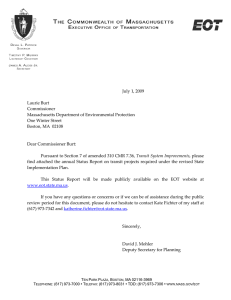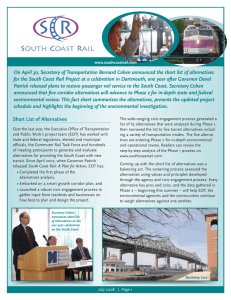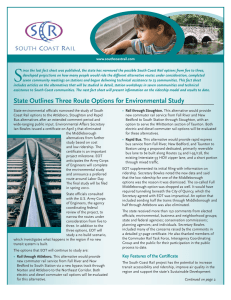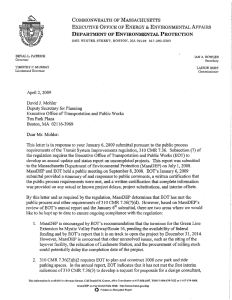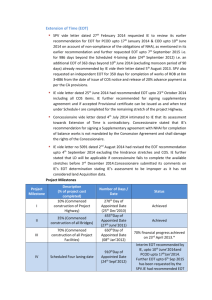T
advertisement
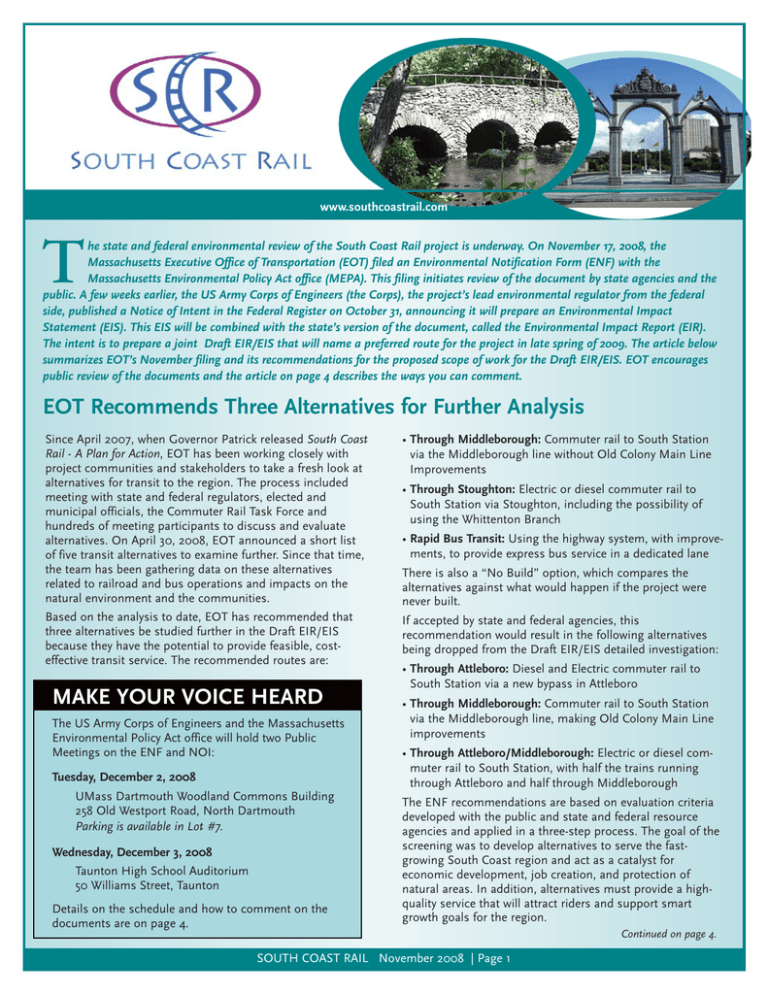
www.southcoastrail.com T he state and federal environmental review of the South Coast Rail project is underway. On November 17, 2008, the Massachusetts Executive Office of Transportation (EOT) filed an Environmental Notification Form (ENF) with the Massachusetts Environmental Policy Act office (MEPA). This filing initiates review of the document by state agencies and the public. A few weeks earlier, the US Army Corps of Engineers (the Corps), the project’s lead environmental regulator from the federal side, published a Notice of Intent in the Federal Register on October 31, announcing it will prepare an Environmental Impact Statement (EIS). This EIS will be combined with the state’s version of the document, called the Environmental Impact Report (EIR). The intent is to prepare a joint Draft EIR/EIS that will name a preferred route for the project in late spring of 2009. The article below summarizes EOT’s November filing and its recommendations for the proposed scope of work for the Draft EIR/EIS. EOT encourages public review of the documents and the article on page 4 describes the ways you can comment. EOT Recommends Three Alternatives for Further Analysis Since April 2007, when Governor Patrick released South Coast Rail - A Plan for Action, EOT has been working closely with project communities and stakeholders to take a fresh look at alternatives for transit to the region. The process included meeting with state and federal regulators, elected and municipal officials, the Commuter Rail Task Force and hundreds of meeting participants to discuss and evaluate alternatives. On April 30, 2008, EOT announced a short list of five transit alternatives to examine further. Since that time, the team has been gathering data on these alternatives related to railroad and bus operations and impacts on the natural environment and the communities. • Through Middleborough: Commuter rail to South Station via the Middleborough line without Old Colony Main Line Improvements Based on the analysis to date, EOT has recommended that three alternatives be studied further in the Draft EIR/EIS because they have the potential to provide feasible, costeffective transit service. The recommended routes are: If accepted by state and federal agencies, this recommendation would result in the following alternatives being dropped from the Draft EIR/EIS detailed investigation: MAKE YOUR VOICE HEARD The US Army Corps of Engineers and the Massachusetts Environmental Policy Act office will hold two Public Meetings on the ENF and NOI: Tuesday, December 2, 2008 UMass Dartmouth Woodland Commons Building 258 Old Westport Road, North Dartmouth Parking is available in Lot #7. Wednesday, December 3, 2008 Taunton High School Auditorium 50 Williams Street, Taunton Details on the schedule and how to comment on the documents are on page 4. • Through Stoughton: Electric or diesel commuter rail to South Station via Stoughton, including the possibility of using the Whittenton Branch • Rapid Bus Transit: Using the highway system, with improve­ ments, to provide express bus service in a dedicated lane There is also a “No Build” option, which compares the alternatives against what would happen if the project were never built. • Through Attleboro: Diesel and Electric commuter rail to South Station via a new bypass in Attleboro • Through Middleborough: Commuter rail to South Station via the Middleborough line, making Old Colony Main Line improvements • Through Attleboro/Middleborough: Electric or diesel com­ muter rail to South Station, with half the trains running through Attleboro and half through Middleborough The ENF recommendations are based on evaluation criteria developed with the public and state and federal resource agencies and applied in a three-step process. The goal of the screening was to develop alternatives to serve the fastgrowing South Coast region and act as a catalyst for economic development, job creation, and protection of natural areas. In addition, alternatives must provide a highquality service that will attract riders and support smart growth goals for the region. SOUTH COAST RAIL November 2008 | Page 1 Continued on page 4. Through Attleboro - Recommended not to advance • Constructability - The difficulty of constructing a new track and catenary system adjacent to the electrified Northeast high speed corridor would result in slow construction and high costs. • Schedule - Design and construction of this alternative would extend the opening of service to 2020. • Cost - This alternative is 1.5 times more expensive than EOT’s budget goal for this project. • Impact to transportation system - Service and operation of the Mansfield, Sharon and Canton commuter rail stations would be impacted. • Impact to historic landmark - Operating this line would require building a new 700-foot span bridge next to the Canton Viaduct, adversely affecting this historic resource. • High direct impacts to wetlands - More than 9 acres of wetland loss. Given the higher cost, significantly longer design and construction schedule, impacts to the existing transportation systems and to the historic Canton Viaduct, EOT recommends that this alternative be removed from further consideration. Through Middleborough - Recommended not to advance • Constructability - This would be the riskiest option to construct since it would require relocating 4.5 miles of the Red Line in the Braintree-Quincy and Boston segments and construction of a 1.3 mile tunnel beneath the existing Quincy Center Station. Temporary operation of the Red Line would require relocation of 22 commercial and residential properties. The Canton Viaduct crosses a deep valley of the east branch of the Neponset River. Through Attleboro/Middleborough - Recommended not to advance This option combines elements of the Attleboro alternative and a simple version of the Middleborough alternative. The original rationale behind this alternative was that no new infrastructure would need to be added to either the Northeast Corridor or the Old Colony Main Line, which goes through Braintree, Quincy and Boston. Unfortunately, EOT’s new operations analysis found that all of the infrastructure required for the Attleboro alternative would still need to be built for this “hybrid” option. Therefore, this option no longer has originally anticipated benefits. Given the higher cost, longer design and construction schedule, impacts to the existing transportation systems, historic Canton Viaduct, and wetlands, EOT recommends that this alternative be removed from further consideration. • Schedule - Design and construction of this alternative will extend the opening of service to 2020. This option would require at least seven years to construct because it would require tunneling beneath the City of Quincy. • Cost - This alternative is 2.4 times more expensive than EOT’s budget goal. • Impact to transportation system - Though construction of a temporary track to divert service around the construction area would minimize the impacts to Red Line service, Red Line shutdowns would still be required. Given the substantially higher cost, significantly longer design and construction schedule and impacts to the existing transportation systems, EOT recommends that this alternative be removed from further consideration. The catenary system of the Northeast Corridor. SOUTH COAST RAIL November 2008 | Page 2 EOT recommends further study of the alternatives through Middleborough (simple), through Stoughton and Rapid Bus in the ENF. SOUTH COAST RAIL November 2008 | Page 3 The Criteria and the Results The Phase 1 Alternatives Analysis evaluated whether an alternative had the potential to meet the project purpose, would be practicable to construct and/or operate and what environmental impacts would result. An alternative is feasible or practicable if it: • Is operationally compatible with the existing transportation infrastructure; • Does not adversely affect the existing or future capacity, reli­ ability, or quality of the regional transportation system in a significant way; • Can be constructed without substantial impacts to the existing transportation system and within a reasonable time frame; • Provides transportation system benefits at a reasonable capital cost; and • Provides sufficient capacity to meet demand. The ENF summarizes the operations, constructability (including the infrastructure that would need to be built, the project’s cost, and length of time it would take to construct and open service), smart growth opportunities, and preliminary assessment of environmental consequences of each alternative. Pages 2 and 3 present a short summary of the reasons EOT believes that three alternatives are not feasible. Civic Engagement Process There are a number of ways you can be involved in reviewing or commenting on the Environmental Notification Form. Copies of the document are available in several ways. You can: • Download the ENF at www.southcoastrail.com • Review it in the reference section of your local library • Request a CD or print copy (contact Charlie Patton at 617-357-5772 x 16 or cpatton@reginavilla.com) South Coast cities and towns also have copies of the ENF, as will those who commented on the previous study. The Corps and MEPA have scheduled two public meetings to help determine what should be studied in the federal and state environmental review of the South Coast Rail Project. The meetings will take place on December 2 at UMass Dartmouth and on December 3 at Taunton High School Auditorium. The format and presentations will be the same at both meetings. Sign-in for those who wish to speak begins at 5:30 p.m., with the meetings beginning at 6:30 p.m. The Corps and MEPA will accept written comments until January 9, 2009. The MEPA office must receive your comments in writing for them to be considered for the project record. Please send your comments to both agencies: Mayor Scott Lang opens the New Bedford Station Workshop. The Corps and MEPA will review the comments submitted by agencies and the public. A scope of work for the project is anticipated at the end of January. EOT anticipates that the Draft EIR/EIS will be filed in late spring 2009. What’s Coming Up Station Workshops: EOT is co-hosting a series of workshops with communities that could host a transit station. The goal of the meetings is to hear local ideas about the potential new stations and what any new development around a station would be like. EOT wants to hear your vision for your neighborhood and potential new station. Workshops will be posted on www.southcoastrail.com and announced through community planning offices, city and town halls and through press releases and email blasts. Technical Assistance: To support sustainable development and smart growth, the Commonwealth is providing communities with tools to review and update their planning and zoning. The goal is to encourage economic development, produce more variety in housing and encourage protection of open space and the environment in the South Coast. As part of the Corridor Plan process, communities were asked what kind of technical assistance they could use in seven areas. EOT received 20 applications and anticipates working with the applicants over the winter. Contact Us If you would like more information about the project or to be added to the project distribution list for email and U.S. Mail notifications of meetings and other updates, please contact Kristina Egan, South Coast Rail Manager at EOT, by email at Kristina.Egan@eot.state.ma.us or phone at 617-973-7314. Project information and updates, including a schedule of upcoming meetings, are posted on the project website at www.southcoastrail.com. • U.S. Army Corps of Engineers, New England District, 696 Virginia Road, Concord, MA 01742-2751; via email: screis@usace.army.mil • Secretary Ian Bowles, EOEEA, attn.: MEPA Office (Aisling Eglington), 100 Cambridge St., Suite 900, Boston, MA 02114; by fax, 617-626-1181; email, aisling.eglington@state.ma.us, or by hand delivery. The Executive Office of Transportation and Public Works Ten Park Plaza, Room 4150 Boston, MA 02116 SOUTH COAST RAIL November 2008 | Page 4
